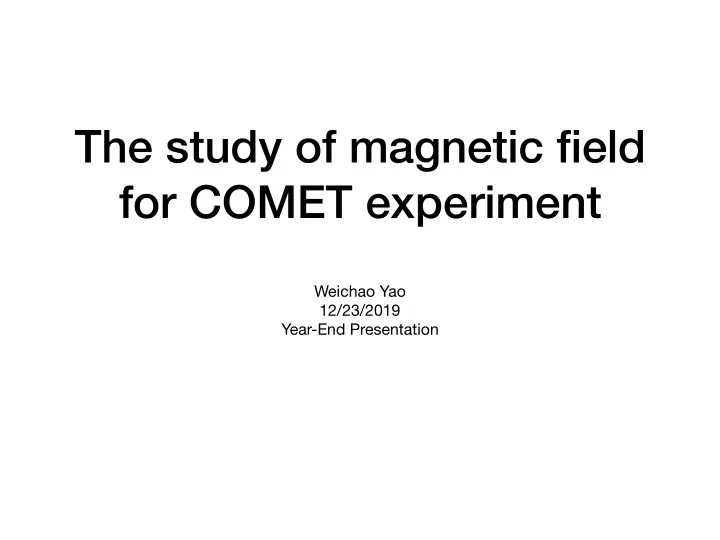

The study of magnetic field for COMET experiment Weichao Yao 12/23/2019 Year-End Presentation
Contents • The magnet used in particle physics experiment • Introduction to motion of charged particle in magnetic field • The optimization of muon target of COMET experiment • Summary
Introduction to LHC & BESIII • Main Dipoles • there is a 27 km long underground tunnel, the Main Bends(MBs, dipole magnets) fill more than 2/3 of the ring • Nominal magnetic filed 8.33T, ultimate field 9 T. • ATLAS • 1 Barrel Toroid, 2 End Cap Toroids and 1 1T SC magnetic Central Solenoid • 2T inner detector • 1T for muon detectors • 4.1T peak in winding
The magnet used In COMET Experiment 5T 1 1 2 2 3T 3T 3 3 4 Here will be 5 4 introduced in this slide 5 ~1.08T 6 1T 6
The motion of charged particle in magnetic field
The distribution of magnetic field Item Material aluminium Shape flat disk Radius 100 mm disk Thickness 200 μ m Number of disks 17 Disk spacing 50 mm 3.214 • The total length of stopping target section is 5m • The default position of Stopping target is 3.214 m • Position? uniform field, slope field
<latexit sha1_base64="LNr0+I2G7HTusGCJcW+VwkdM=">ACIXicbVDLSsNAFJ3UV62vqEs3g0VwVRIf2I1Q6sZlhb6kCWEymbRDJw9nJoUS8ytu/BU3LhTpTvwZJ20Wr0wzOGc7n3HjdmVEjD+NRK6tr6xvlzcrW9s7unr5/0BVRwjHp4IhFvO8iQRgNSUdSyUg/5gQFLiM9d3yT670J4YJGYVtOY2IHaBhSn2IkFeXo9YmTWo8ZtHyOcGq5EfPENFBf2s6y9D67i+UAObGmPBY0Q+wmTl61agZ84J/gVmAKiq5egzy4twEpBQYoaEGJhGLO0UcUkxI1nFSgSJER6jIRkoGKACDudX5jBE8V40I+4eqGEc/ZnR4oCke+tnAGSI7Gs5eR/2iCRft1OaRgnkoR4MchPGJQRzOCHuUESzZVAGFO1a4Qj5BKRKpQKyoEc/nkv6B7VjPa5d3F9VGs4ijDI7AMTgFJrgCDXALWqADMHgCL+ANvGvP2qv2oc0W1pJW9ByCX6V9fQNqFqWE</latexit> <latexit sha1_base64="bseJNQtCw1AdLBHemcAzxXJ4U=">ACKHicbVDLSgMxFM34rPVdekmWARXZcYHuhFL3bisYLXSKSWTZmwyYzJnUIZ5nPc+CtuRBTp1i8x087C14HA4ZxzubkniAU34LpjZ2Z2bn5hsbRUXl5ZXVuvbGxemyjRlLVoJCLdDohgivWAg6CtWPNiAwEuwnuz3P/Zsi04ZG6glHMupLcKR5ySsBKvcrZEPs0MtiHAQOC/VATmuJ9P+ZYZuntA25kp+2pKrHNGq6KbJbmZq9SdWvuBPgv8QpSRQWavcqr349oIpkCKogxHc+NoZsSDZwKlpX9xLCY0HtyxzqWKiKZ6aTQzO8a5U+DiNtnwI8Ub9PpEQaM5KBTUoCA/Pby8X/vE4C4Uk35SpOgCk6XRQmAkOE89Zwn2tGQYwsIVRz+1dMB8S2Arbsi3B+3yX3K9X/MOakeXh9V6o6ijhLbRDtpDHjpGdXSBmqiFKHpEz+gNvTtPzovz4Yyn0RmnmNlCP+B8fgHdmKXk</latexit> <latexit sha1_base64="B0qNr3qsMeMDF3xy16p4EN5Cp+k=">ACMHicbVDLSgMxFM3UV62vUZdugkVwVa1+FgIpS50WaEvaEvJpJk2NJkZk0yhDPNJbvwU3Sgo4tavMNMZpLUeCJx7zr3c3GP7jEplW9GZmV1bX0ju5nb2t7Z3TP3D5rSCwQmDewxT7RtJAmjLmkoqhp+4IgbjPSsc3sd+aECGp59bV1Cc9joYudShGSkt987Z+3XUEwmEJdn0KROonklrmFScziJwgdYXfAhT7S+mbcK1gxwmRTkgcpan3zuTvwcMCJqzBDUnaKlq96IRKYkaiXDeQxEd4jIako6mLOJG9cHZwBE+0MoCOJ/RzFZyp8xMh4lJOua07OVIj+deLxf+8TqCcy15IXT9QxMXJIidgUHkwTg8OqCBYsakmCAuq/wrxCOk0lM4NwvhKsb578nLpFkqFM8K5ftyvlJN48iCI3AMTkERXIAKuAM10AYPIX8A4+jCfj1fg0vpLWjJHOHIFGN8/DiOpvQ=</latexit> <latexit sha1_base64="YEqH2UrFamNqwm082dq7uVpSspE=">ACAHicbVDLSsNAFJ34rPUVdeHCzWARXJWkFh8LodSNywr2AW0sk+mkHTqTxJlJoYRs/BU3LhRx62e482+cpEHUeuDC4Zx7ufceN2RUKsv6NBYWl5ZXVgtrxfWNza1tc2e3JYNIYNLEAQtEx0WSMOqTpqKkU4oCOIuI213fJX67QkRkgb+rZqGxOFo6FOPYqS01Df37+E1i97nkA45nByF1eSJBZJ3yxZSsDnCd2TkogR6NvfvQGAY48RVmSMqubYXKiZFQFDOSFHuRJCHCYzQkXU19xIl04uyB5pZQC9QOjyFczUnxMx4lJOuas7OVIj+dLxf+8bqS8cyemfhgp4uPZIi9iUAUwTQMOqCBYsakmCAuqb4V4hHQWSmdWzEK4SH6/fI8aVXK9km5elMt1ep5HAVwA7BMbDBGaiBa9ATYBAh7BM3gxHown49V4m7UuGPnMHvgF4/0LOPOWVA=</latexit> The motion of charged particle qvB = mv 2 r T = 2 π r = 2 π mv qB = 2 π m v v qB • The period of motion will be changed with magnetic field • The radius slightly larger, and the trajectory length became large • the target design: the gap of start disks should be small and the gap of end disks should be large T Y = X mv ? v cos θ 2 π m Y qB = X mv sin θ • If we set L =X ∙ r, v k qB qB •
Energy deposit in target disks θ • If there is no magnetic field, the initial angle larger than θ , the hit number of particles is zero. The gap between disks more large more better. • The energy loss of electron with 105MeV in Aluminium : • βγ =105MeV/0.51=205.88, dE/dx ≈ -2.18 (MeV/g cm2), so Edep is 2.18 × 2.7= 5.86 MeV/cm: if the thickness is 0.2mm, then edep is 117.72 keV • There magnetic field in this section, the motion of charged particle will be helix
<latexit sha1_base64="W4OM/b/oSgKv39ecA4jFkiU1Hes=">ACOXicbVDLSgMxFM3UV62vqks3wSK4KGWmCroRSt24rGAf0Kklk2ba0GQmJlCGfJbvwLd4IbF4q49QdMH4vaeiBwOdcbu4JBKNKu+6rk1lb39jcym7ndnb39g/yh0cNFScSkzqOWSxbAVKE0YjUNdWMtIQkiAeMNIPh7cRvjohUNI4e9FiQDkf9iIYUI2lbr7m8+TGDyXCKYejbuoWfUGkMI9p2Zi0DKtWMmYxIajGgyJciU1Y7r5gltyp4CrxJuTApij1s2/+L0YJ5xEGjOkVNtzhe6kSGqKGTE5P1FEIDxEfdK2NEKcqE46vdzAM6v0YBhL+yINp+riRIq4UmMe2CRHeqCWvYn4n9dOdHjdSWkEk0iPFsUJgzqGE5qhD0qCdZsbAnCktq/QjxAtiRty87ZErzlk1dJo1zyLkrl+8tCpTqvIwtOwCk4Bx64AhVwB2qgDjB4Am/gA3w6z8678+V8z6IZz5zDP7A+fkFwGquHw=</latexit> <latexit sha1_base64="2ywr5fC9OtEoFeDx9Ic4UEjXI0=">ACEnicbVC7SgNBFJ31GeMramkzGISkCbtR0EYIsbGMYB6QjWF2MpsMmZ1dZu4KYdlvsPFXbCwUsbWy82+cJFto4oHLPZxzLzP3eJHgGmz721pZXVvf2Mxt5bd3dvf2CweHLR3GirImDUWoOh7RTHDJmsBsE6kGAk8wdre+Hrqtx+Y0jyUdzCJWC8gQ8l9TgkYqV8ou74iNKn3EztNpy3iQEdpeuVqLvF9Uk1LowYkHK/ULQr9gx4mTgZKaIMjX7hyx2ENA6YBCqI1l3HjqCXEAWcCpbm3ViziNAxGbKuoZIETPeS2UkpPjXKAPuhMiUBz9TfGwkJtJ4EnpkMCIz0ojcV/O6MfiXvYTLKAYm6fwhPxYQjzNBw+4YhTExBCFTd/xXRETEZgUsybEJzFk5dJq1pxzirV2/NirZ7FkUPH6ASVkIMuUA3doAZqIoe0TN6RW/Wk/VivVsf89EVK9s5Qn9gf4AgSud+Q=</latexit> The charged particle in gradient field: Mirror effect • the magnetic moment is considered the lowest- order approximation of the adiabatic invariant • At the reverse point, the ν ⫽ =0. • Magnetic moment is conserved mv 2 mv 2 ν 0 , ⊥ pitch, ⊥ µ = = ν ⊥ 2 B 0 2 B pitch θ • Therefore B ν ⫽ B 0 = sin 2 ( θ ) B pitch • Particles with appropriate angle will mirror in regions of higher B, If θ is too small, particle does not mirror. • Bmax =3T: • If B=1.5T, θ =45 degree; if B=2.1T, then θ =56.8 degree; if B=2.5T, then θ =66 degree • the particle within angle> θ could be reflected. 9
<latexit sha1_base64="hTA/OqKgE8qwMTm69CvIgTdOeUE=">ACQHicbZDBa9swFMbldN26rNvS9riLWBikhwU7K3SXQumg9DQ6WJpC7BpZfk5EZdlIz6VB+E/rZX/Cbjv30kPH2HWnKYkPS7sHgk/fex9P+iWlFAZ9/4fXWnuy/vTZxvP2i82Xr153trbPTFpDkNeyEKfJ8yAFAqGKFDCeamB5YmEUXL5ad4fXYE2olBfcVZClLOJEpngDJ0Vd0afYxsiXCO1GjIJHCGt64Pj2Prvw0wzbsNS1HZQ1zQUCt3winhwlNAVtM05IWhveV1l8adrt/3F0Ufi6ARXdLUadz5HqYFr3JQyCUzZhz4JUaWaRcQt0OKwMl45dsAmMnFcvBRHYBoKbvnJPSrNDuKQL9+EZbkxszxkznDqXnYm5v/640rzD5GVqiyQlB8uSirJMWCzmnSVGiHTM6cYFwL91bKp8wRQse87SAED7/8WJwN+sGH/uDLXvfwqMGxQd6Qt6RHArJPDskJOSVDwskNuSX35Kf3zbvzfnm/l6Mtr8nskJXy/vwFnDWxhA=</latexit> <latexit sha1_base64="5MSBOV6KyAgNd5tJ9C2Su7dEx/A=">ACa3icbVHRShwxFM2M1ura6lYfFPUhdBEs6DKzCvalIArio5auCjvbIZO94wYzmSG5IyxhXvqJfesf9MV/MLO7gqteCJx7zrnc5CQpDAYBP8f27+w8LHxaXG8qfPK6vNL2vXJi81hy7PZa5vE2ZACgVdFCjhtDAskTCTXJ/Vus3D6CNyNUvHBXQz9idEqngDB0VN/8ZAg/olQzTu15bIP9MbZRISrbqaqJg9ct18z1bMzrMVIKIztrP+3jXAIyCo6iHhu6N6k/UZnJ19KcbMVtINx0bcgnIWmdZl3PwbDXJeZqCQS2ZMLwK7FumUXAJVSMqDRSM37M76DmoWAamb8dZVXTXMQOa5todhXTMvpywLDNmlCXOmTEcmtdaTb6n9UpMv/etUEWJoPhkUVpKijmtg6cDoYGjHDnAuBburpQPmcsE3fc0XAjh6ye/BdednjY7lwdtU5Op3Eskm3yleyRkByTE3JBLkmXcPLfW/E2vE3v0V/3t/ydidX3pjPrZKb83Sefr7tU</latexit> <latexit sha1_base64="WvnQbqKJ2DeF6vfICQ18SjY5E=">ACNnicbVDLSgMxFM34tr6qLt0Ei6CbMlMF3QiIG4UBatCp5ZM5o4NzWSG5I5YhvkqN36HOzcuFHrJ5g+EF8HAifnEtyT5BKYdB1n5yR0bHxicmp6dLM7Nz8Qnlx6cIkmeZQ54lM9FXADEihoI4CJVylGlgcSLgMOgc9/IWtBGJOsduCs2Y3SgRCc7QSq3y8Ukr9xHukOYaIgkcISyKXV8otEakGc/9VBR5rSiubANyAp6uD5gGzT0eWLo17VrhVtw/6l3hDUiFDnLbKj36Y8CwGhVwyYxqem2IzZxoFl1CU/MxAyniH3UDUsViM28v3ZB16wS0ijR9ikfX7RM5iY7pxYJMxw7b57fXE/7xGhtFOMxcqzRAUHzwUZJiQnsd0lBoW5TsWsK4FvavlLeZ7Qpt0yVbgvd75b/kolb1Nqu1s63K3v6wjimyQlbJOvHINtkjR+SU1Akn9+SJvJBX58F5dt6c90F0xBnOLJMfcD4+AYDdrOA=</latexit> The calculation of mirror effect Z θ N reflected = F ( θ ) d cos( θ ) π 2 • Because the change with cos( θ ) is same, Z θ N reflected = F 0 − π d cos( θ ) 2 π 2 • F (0- π /2) reflected, the total events is F (- π — π ) Z θ Rate = F 0 , π = 1 d cos( θ ) = 1 2 2 cos( θ ) 2 F − π , π π 2 • From above, the calculation is larger than simulation. • The distribution of particle is uniform with Cos θ , • Because the too small velocity could not be reflected, The calculation is a little di ff erent with simulation (about 1~2 %)
Reflected rate of electron velocity v v z θ mirror e ff ect axis • The definition of the angle θ • Cos θ = v z / v • The maximum v z corresponding to to pitch angle upstream, reflected • if θ > pitch angle, the charged particle could be reflected, Downstream however if the θ is too large, it also could not be reflected θ >40 degree 11
The charged particle motion w/wo gradient field 2T with slope field 2T uniform • The mirror e ffi ciency will be e ff ected by the gradient field • If using the uniform field, the electron with small angle will be lost. The gradient field is necessary
The study of the optimization of stopping target • Purpose: • Increasing the muons yield in stopping target • improving the signal acceptance • Method: • Magnetic field option • The parameters of Stopping target: Number disks, Position, disks gap etc.
The options of Magnetic field • Using the gradient field • The default: center 1.8T, dB/dm=1.343 • Case1: center 2T, gradient < default • Improving the average field during • Case2: center 2.1T, gradient< default the Stopping target • Case3:center 2T, gradient ~> default • Changing the slope rate • Case4: center 2T, gradient > default • Changing the position
Recommend
More recommend